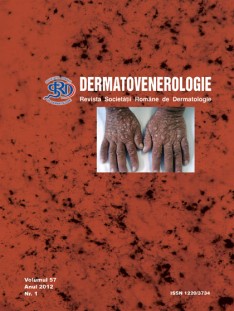Studii clinice si experimentale
Expresia dopaminei în melanomul malign
Introducere.
Rapoarte recente exploreaza rolul catecolaminelor in proliferarea celulelor maligne si controlul raspunsului imun la pacientii cu boala neoplazica. Epinefrina si norepinefrina supraregleaza sinteza unor factori proangiogenici in celulele maligne si induc angiogeneza in tesuturile tumorale. In schimb, dopamina inhiba angiogeneza prin supresia actiunii VEGF in celulele endoteliale. La nivel cutanat, au fost detectate sisteme enzimatice care asigura sinteza si degradarea catecolaminelor precum si receptorii corespunzatori. Pornind de la aceste considerente, scopul autorilor a fost stabilirea profilului dopaminei la pacientii cu melanom.
Rapoarte recente exploreaza rolul catecolaminelor in proliferarea celulelor maligne si controlul raspunsului imun la pacientii cu boala neoplazica. Epinefrina si norepinefrina supraregleaza sinteza unor factori proangiogenici in celulele maligne si induc angiogeneza in tesuturile tumorale. In schimb, dopamina inhiba angiogeneza prin supresia actiunii VEGF in celulele endoteliale. La nivel cutanat, au fost detectate sisteme enzimatice care asigura sinteza si degradarea catecolaminelor precum si receptorii corespunzatori. Pornind de la aceste considerente, scopul autorilor a fost stabilirea profilului dopaminei la pacientii cu melanom.
Material si Metoda.
Studiul a fost realizat pe o perioada de 2 ani, având la baza monitorizarea a 64 pacienti cu melanom in diferite faze de evolutie, 5 pacienti cu melanoza precanceroasa circumscrisa Dubreuihl, 40 subiecti cu tumori nevice si 40 voluntari sanatosi.
Probele biologice (sânge, urina, tesut tumoral/sanatos) au fost prelevate inainte de inceperea tratamentului. Determinarea dopaminei s-a facut prin metoda ELISA.
Rezultate.
Pacientii cu melanom prezinta un model diferit al expresiei dopaminei comparativ cu celelalte situatii clinice studiate. La acestia, s-a detectat o concentratie scazuta a dopaminei in plasma (48,2 ± 16,1 pg/ml versus 58,5 ± 25,3 pg/ml la control, respectiv 64,1 ± 39,7 pg/ml in nevi si 53,6 ± 21,8 pg/ml in melanoza circumscrisa) si urina (148,5 ± 91,6 ug/24 h versus 201,6 ± 160,7 ug/24 h la control, respectiv 207,4 ± 147,8 ug/24 h in nevi si 210,1 ± 37,2 ug/24 h in melanoza circumscrisa). In plus, dopamina tisulara este mai abundenta in proliferarile benigne ale melanocitelor in comparatie cu tesuturile maligne (712,0 ± 81,5 pg/g proteina in nevi, 501,7 ± 171,4 pg/g proteina in melanom, respectiv 602,7 ± 106,1 pg/g proteina in tesutul sanatos peritumoral), indicând implicarea acesteia in proliferarea celulara.
Concluzii.
Scaderea dopaminei tinde sa se asocieze cu stadiile avansate ale neoplaziei.
Aceste rezultate sustin ideea conform careia catecolaminele sunt factori esentiali in dezvoltarea tumorala, indeosebi in procesul de metastazare.
Cuvinte cheie: dopamina, angiogeneza, melanom.


